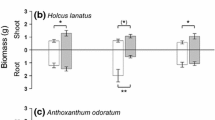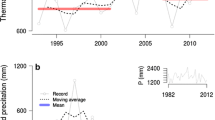Abstract
We studied the degree and scale of patchiness of vegetation and selected soil variables along a gradient of herbivore impact. The gradient consisted of a radial pattern of `high', `intermediate' and `low' herbivore impact around a watering point in a semi-arid environment in Burkina Faso (West Africa). We hypothesised that, at a certain range of herbivore impact, vegetated patches alternating with patches of bare soil would occur as a consequence of plant-soil feedbacks and run-off-run-on patterns. Indeed, our transect data collected along the gradient showed that vegetated patches with a scale of about 5–10 m, alternating with bare soil, occurred at intermediate herbivore impact. When analysing the data from the experimental sites along the gradient, however, we also found a high degree of patchiness of vegetation and soil variables in case of low and high herbivore impact. For low herbivore impact, most variation was spatially explained, up to 100% for vegetation biomass and soil temperature, with a patch scale of about 0.50 m. This was due to the presence of perennial grass tufts of Cymbopogon schoenanthus. Patterns of soil organic matter and NH4-N were highly correlated with these patterns of biomass and soil temperature, up to r=0.7 (P<0.05) for the in situ correlation between biomass and NH4-N. For high herbivore impact, we also found that most variation was spatially explained, up to 100% for biomass and soil temperature, and 84% for soil moisture, with three distinct scales of patchiness (about 0.50 m, 1.80 m and 2.80 m). Here, microrelief had a corresponding patchy structure. For intermediate herbivore impact, again most variation was spatially explained, up to 100% for biomass and soil temperature, and 84% for soil moisture, with a patch scale of about 0.95 m. Here, we found evidence that vegetated patches positively affected soil moisture through less run-off and higher infiltration of rainwater that could not infiltrate into the bare soil elsewhere, which was not due to microrelief. Thus, we conclude that our findings are in line with our initial hypothesis that, at intermediate herbivore impact, vegetated patches alternating with patches of bare soil persist in time due to positive plant-soil feedbacks.
Similar content being viewed by others
References
Andrew, M. H. 1988. Grazing impact in relation to livestock watering points. Trends Ecol. Evol. 12: 336–339.
Bolton, H. Jr, Smith, J. L. & Link, S. O. 1993. Soil microbial biomass and activity of a disturbed and undisturbed shrub-steppe ecosystem. Soil Biol. Biochem. 25: 545–552.
Breman, H. & De Wit, C. T. 1983. Rangeland productivity and exploitation in the Sahel. Science 221: 1341–1347.
Burrough, P. A. 1995. Spatial aspects of ecological data. Pp. 213–251. In: Jongman, R. H. G., Ter Braak, C. J. F. & Van Tongeren, O. F. R. (eds), Data Analysis in Community and Landscape Ecology. Cambridge University Press, Cambridge.
Buurman, P., Pape Th. & Muggler, C. C. 1997. Laser grain-size determination in soil genetic studies. 1. Practical problems. Soil Sci. 162: 211–218.
Elwell, H. A. & Stocking, M. A. 1976. Vegetal cover to estimate soil erosion hazard in Rhodesia. Geoderma 15: 61–70.
Gross, K. L., Pregitzer K. S. & Burton, A. J. 1995. Spatial variation in nitrogen availability in three successional plant communities. J. Ecol. 83: 357–367.
Jackson, R. B. & Caldwell, M. M. 1993. Geostatistical patterns of soil heterogeneity around individual perennial plants. J. Ecol. 81: 683–692.
Kamphorst, A. 1987. A small rainfall simulator for the determination of soil erodibility. Neth. J. Agric. Sci. 35: 407–414.
Kelly, R. D. & Walker, B. H. 1976. The effects of different forms of land use on the ecology of a semi-arid region in south-eastern Rhodesia. J. Ecol. 64: 553–576.
Kiepe, P. 1995. No runoff, no soil loss; soil and water conservation in hedgerow barrier systems. Tropical Resource Management Papers no. 10. Wageningen Agricultural University, Wageningen.
Ludwig, J. A. & Tongway, D. J. 1995. Spatial organisation of landscapes and its function in semi-arid woodlands, Australia. Landscape Ecol. 10: 51–63.
Mulders, M. A. 1996. Soil and land use of the Kaibo area at medium scale. Programme de Recherche Aménagement et Gestion de l'Espace Sylvo-Pastoral au Sahel, Antenne Sahélienne de l'Université Agronomique Wageningen, Pays-Bas et de l'Université de Ouagadougou, Burkina Faso.
Rietkerk, M., Van den Bosch, F. & Van de Koppel, J. 1997. Site-specific properties and irreversible vegetation changes in semiarid grazing systems. Oikos 80: 241–252.
Rietkerk, M. & Van de Koppel, J. 1997. Alternate stable states and threshold effects in semi-arid grazing systems. Oikos 79: 69–76.
Robertson, G. P. & Gross, K. L. 1994. Assessing the heterogeneity of belowground resources: quantifying pattern and scale. Pp 237–252. In: Caldwell, M. M. & Pearcy, R. W. (eds), Exploitation of Environmental Heterogeneity by Plants. Academic Press, New York.
Robertson, G. P., Huston, M. A., Evans, F. C. & Tiedje, J. H. 1988. Spatial variability in a successional plant community: patterns of nitrogen availability. Ecology 69: 1517–1524.
Robertson, G. P., Klingensmith, K. M., Klug, M. J., Paul, E. A., Crum, J. R. & Ellis, B. G. 1997. Soil resources, microbial activity, and primary production across an agricultural ecosystem. Ecol. Applic. 7: 158–170.
Ryel, R. J., Caldwell, M. M. & Manwaring, J. H. 1996. Temporal dynamics of spatial heterogeneity in sagebrush-wheatgrass steppe during a growing season. Plant Soil 184: 299–309.
Schlesinger, W. H., Raikes, J. A., Hartley, A. E. & Cross, A. F. 1996. On the spatial pattern of soil nutrients in desert ecosystems. Ecology 77: 364–374.
Schlesinger, W. H., Reynolds, J. F., Cunningham, G. L., Huenneke, L. F., Jarrell, W. M., Virginia, R. A. & Whitford, W. G. 1990. Biological feedbacks in global desertification. Science 247: 1043–1048.
Stark, J. M. 1994. Causes of soil nutrient heterogeneity at different scales. Pp. 255–284. In: Caldwell, M. M. & Pearcy, R. W. (eds), Exploitation of Environmental Heterogeneity by Plants. Academic Press, New York.
Stein, A., Brouwer, J. & Bouma, J. 1997. Methods for comparing spatial variability patterns of millet yield and soil data. Soil Sci. Soc. Am. J. 61: 861–870.
Stroosnijder, L. 1976. Infiltratie en herverdeling van water in de grond (Versl. Landbouwk. Onderz. 847). Pudoc, Wageningen.
Stroosnijder, L. 1996. Modelling the effect of grazing on infiltration, runoff and primary production in the Sahel. Ecol. Modelling 92: 79–88.
Tolsma, D. J., Ernst W. H. O. & Verwey, R. A. 1987. Nutrients in soil and vegetation around two artificial waterpoints in eastern Botswana. J. Appl. Ecol. 24: 991–1000.
Tongway, D. J. & Ludwig, J. A. 1994. Small-scale heterogeneity in semi-arid landscapes. Pacific Cons. Biol. 1: 201–208.
Valentin, C. 1985. Effects of grazing and trampling on soil deterioration around recently drilled water holes in the Sahelian Zone. Pp 51–65. In: El-Swaify, S. A., Moldenhauer, W. C. & Lo, A. (eds), Soil Erosion and Conservation. Soil Conservation Society of America, Ankeny.
Van Breemen, N. 1993. Soils as biotic constructs favouring net primary productivity. Geoderma 57: 183–211.
Vinton, M. A. & Burke, I. G. 1995. Interactions between individual plant species and soil nutrient status in shortgrass steppe. Ecology 76: 1116–1133.
Wedin, D. A. & Tilman, D. 1990. Species effects on nitrogen cycling: a test with perennial grasses. Oecologia 84: 433–441.
Wilson, J. B. & Agnew, A. D. Q. 1992. Positive-feedback switches in plant communities. Adv. Ecol. Res. 23: 264–336.
Author information
Authors and Affiliations
Rights and permissions
About this article
Cite this article
Rietkerk, M., Ketner, P., Burger, J. et al. Multiscale soil and vegetation patchiness along a gradient of herbivore impact in a semi-arid grazing system in West Africa. Plant Ecology 148, 207–224 (2000). https://doi.org/10.1023/A:1009828432690
Issue Date:
DOI: https://doi.org/10.1023/A:1009828432690




